How to revoke permissions granted to coinglide.site
Notification SpamAlso Known As: Ads by coinglide.site
Get free scan and check if your device is infected.
Remove it nowTo use full-featured product, you have to purchase a license for Combo Cleaner. Seven days free trial available. Combo Cleaner is owned and operated by RCS LT, the parent company of PCRisk.com.
What kind of page is coinglide[.]site?
In our examination of coinglide[.]site, we found that it employs clickbait, a misleading technique, to trick visitors into permitting it to show notifications. Usually, notifications from websites like coinglide[.]site promote other shady sites. Thus, permission for dubious sites should never be given.
![coinglide[.]site ads](/images/stories/screenshots202502/coinglide-site-ads-main.jpg)
Coinglide[.]site in detail
Coinglide[.]site instructs visitors to click "Allow" to confirm that they are not robots. It also features a reCAPTCHA logo, an "I'm not a robot" message, and a fake checkbox. The purpose of coinglide[.]site is to trick visitors into believing they have to click "Allow" to pass a CAPTCHA.
However, clicking "Allow" (which is an option provided by a browser when coinglide[.]site is visited) grants the site permission to show notifications. These notifications can direct users to other harmful or deceptive websites that may infect their system or trick them into giving away personal details (e.g., credit card details or login credentials).
Also, notifications from coinglide[.]site can lead to web pages designed to steal money (e.g., to lure unsuspecting users into paying for fake or unnecessary products or services). Through notifications delivered by coinglide[.]site, users may become victims of identity theft, suffer monetary loss, have their computers infected, and experience other issues.
If coinglide[.]site or a similar web page has been granted permission to send notifications, this permission should be revoked as soon as possible. Our guide on removing such permissions is provided below.
| Name | Ads by coinglide.site |
| Threat Type | Push notifications ads, Unwanted ads, Pop-up ads |
| Detection Names | N/A (VirusTotal) |
| Serving IP Address | 23.204.11.32 |
| Symptoms | Seeing advertisements not originating from the sites you are browsing. Intrusive pop-up ads. Decreased Internet browsing speed. |
| Distribution Methods | Deceptive pop-up ads, false claims within visited websites, unwanted applications (adware) |
| Damage | Decreased computer performance, browser tracking - privacy issues, possible additional malware infections. |
| Malware Removal (Windows) |
To eliminate possible malware infections, scan your computer with legitimate antivirus software. Our security researchers recommend using Combo Cleaner. Download Combo CleanerTo use full-featured product, you have to purchase a license for Combo Cleaner. 7 days free trial available. Combo Cleaner is owned and operated by RCS LT, the parent company of PCRisk.com. |
Similar sites in general
Websites of this type trick users into agreeing to receive notifications, which they then use to send fake alerts or other messages promoting scams, malware, and other online threats. These sites are often accessed through fake ads, annoying pop-ups, phishing emails, or sites that use unreliable ad networks (e.g., torrent and illegal streaming sites).
Some examples of similar pages are uptotheminute[.]site, dailybuzznews[.]site, and getpremiumapp[.]monster.
How did coinglide[.]site gain permission to deliver spam notifications?
Websites need explicit permission from users to send notifications. When you visit a site, your browser might ask if you want to allow the site to send you notifications. If you click "Allow", you are granting the website permission to send notifications. In the case of coinglide[.]site , it is sending notifications because it has been granted this permission.
How to prevent deceptive sites from delivering spam notifications?
If a questionable site requests you to click "Allow" to verify you are not a robot or for any other reason, you should choose "Block", "Deny", or "Block Notifications" in the pop-up that appears in your browser. Another way to avoid unwanted notifications is to close suspicious websites without interacting with them.
If you are receiving unwanted notifications, we recommend running a scan with Combo Cleaner Antivirus for Windows to automatically eliminate them.
Appearance of coinglide[.]site website (GIF):
![coinglide[.]site website appearance (GIF)](/images/stories/screenshots202502/coinglide-site-ads-appearance.gif)
Notification from coinglide[.]site:
![coinglide[.]site notification](/images/stories/screenshots202502/coinglide-site-ads-notification.jpg)
Instant automatic malware removal:
Manual threat removal might be a lengthy and complicated process that requires advanced IT skills. Combo Cleaner is a professional automatic malware removal tool that is recommended to get rid of malware. Download it by clicking the button below:
DOWNLOAD Combo CleanerBy downloading any software listed on this website you agree to our Privacy Policy and Terms of Use. To use full-featured product, you have to purchase a license for Combo Cleaner. 7 days free trial available. Combo Cleaner is owned and operated by RCS LT, the parent company of PCRisk.com.
Quick menu:
- What is Ads by coinglide.site?
- STEP 1. Remove spam notifications from Google Chrome
- STEP 2. Remove spam notifications from Google Chrome (Android)
- STEP 3. Remove spam notifications from Mozilla Firefox
- STEP 4. Remove spam notifications from Microsoft Edge
- STEP 5. Remove spam notifications from Safari (macOS)
Disable unwanted browser notifications:
Video showing how to disable web browser notifications:
 Remove spam notifications from Google Chrome:
Remove spam notifications from Google Chrome:
Click the Menu button (three dots) on the right upper corner of the screen and select "Settings". In the opened window select "Privacy and security", then click on "Site Settings" and choose "Notifications".
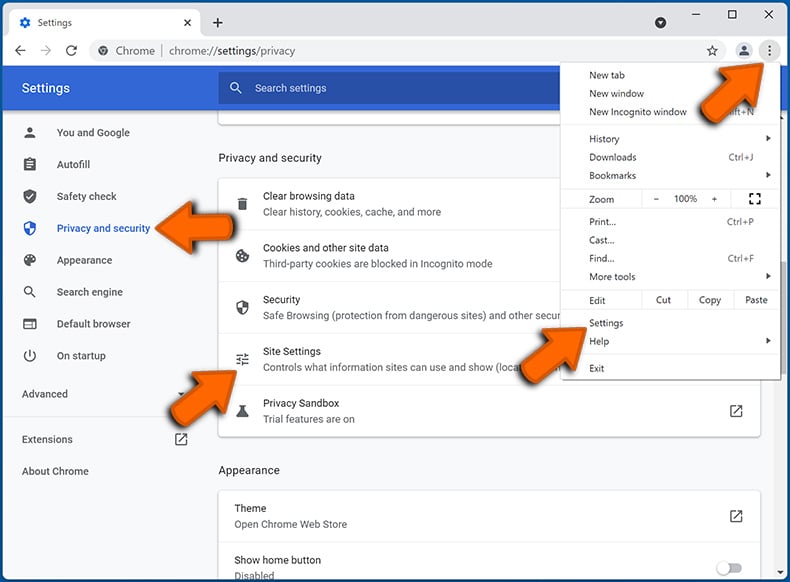
In the "Allowed to send notifications" list search for websites that you want to stop receiving notifications from. Click on the three dots icon near the website URL and click "Block" or "Remove" (if you click "Remove" and visit the malicious site once more, it will ask to enable notifications again).
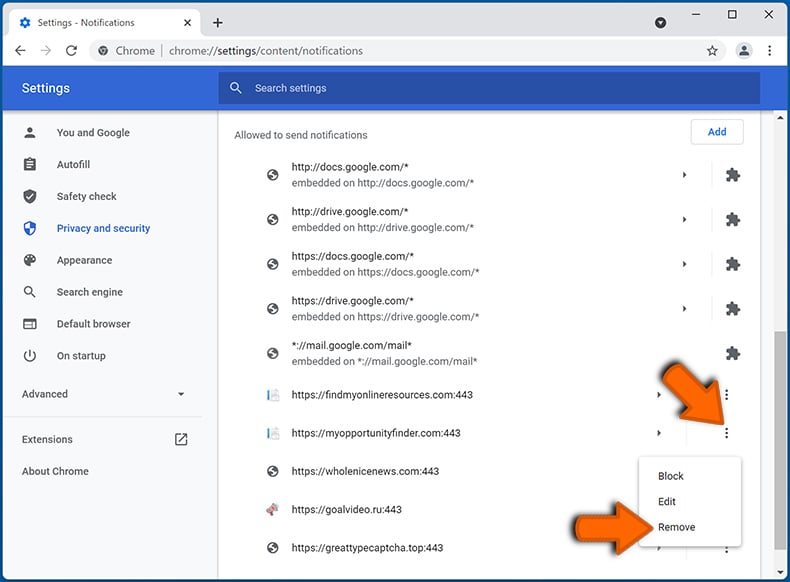
 Remove spam notifications from Google Chrome (Android):
Remove spam notifications from Google Chrome (Android):
Tap the Menu button (three dots) on the right upper corner of the screen and select "Settings". Scroll down, tap on "Site settings" and then "Notifications".
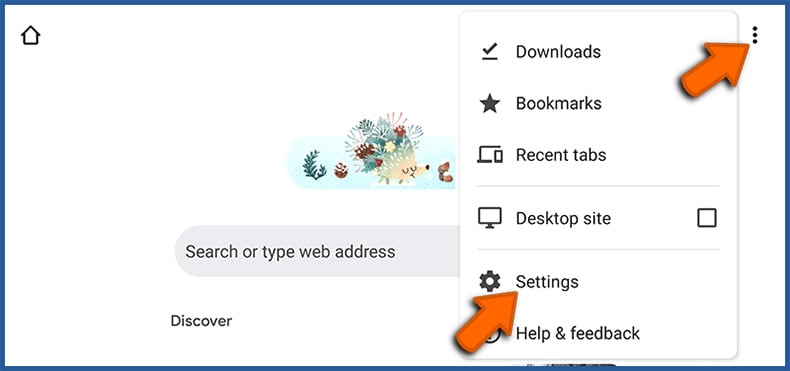
In the opened window, locate all suspicious URLs and tap on them one-by-one. Once the pop-up shows up, select either "Block" or "Remove" (if you tap "Remove" and visit the malicious site once more, it will ask to enable notifications again).
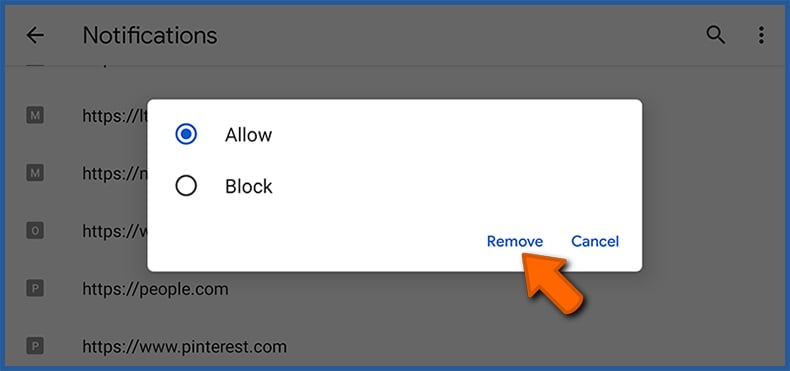
 Remove spam notifications from Mozilla Firefox:
Remove spam notifications from Mozilla Firefox:
Click the Menu button (three bars) on the right upper corner of the screen. Select "Settings" and click on "Privacy & Security" in the toolbar on the left hand side of the screen. Scroll down to the "Permissions" section and click the "Settings" button next to "Notifications".
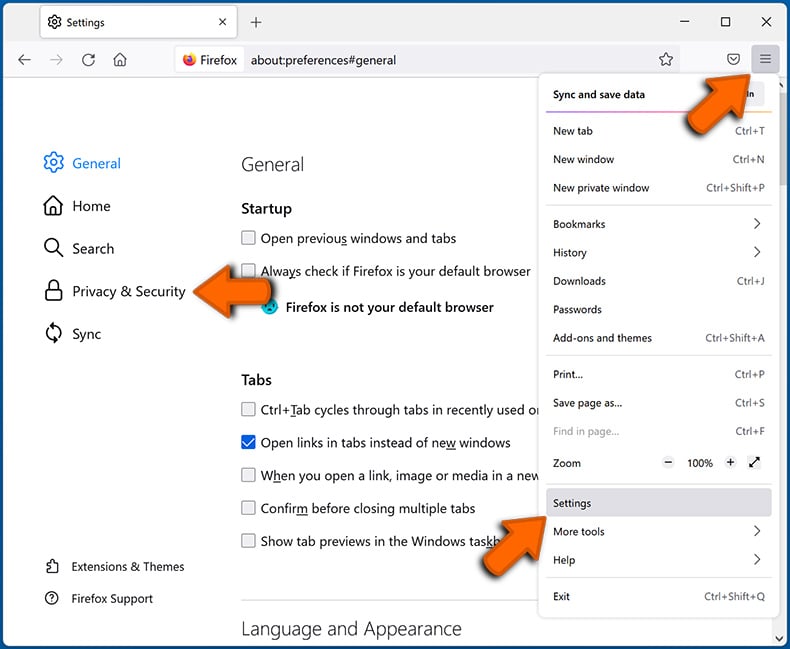
In the opened window, locate all suspicious URLs and block them using the drop-down menu or either remove them by clicking "Remove Website" at the bottom of the window (if you click "Remove Website" and visit the malicious site once more, it will ask to enable notifications again).
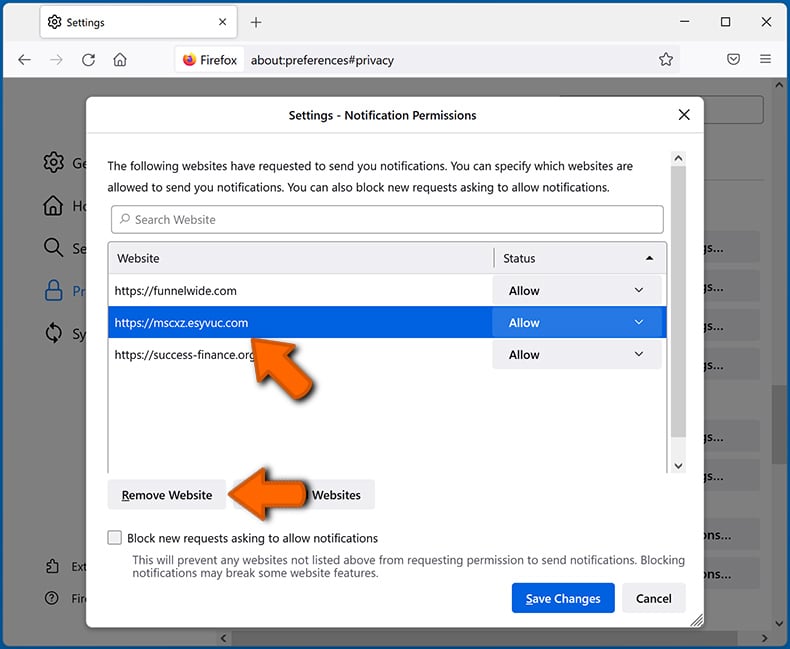
 Remove spam notifications from Microsoft Edge:
Remove spam notifications from Microsoft Edge:
Click the menu button (three dots) on the right upper corner of the Edge window and select "Settings". Click on "Cookies and site permissions" in the toolbar on the left hand side of the screen and select "Notifications".
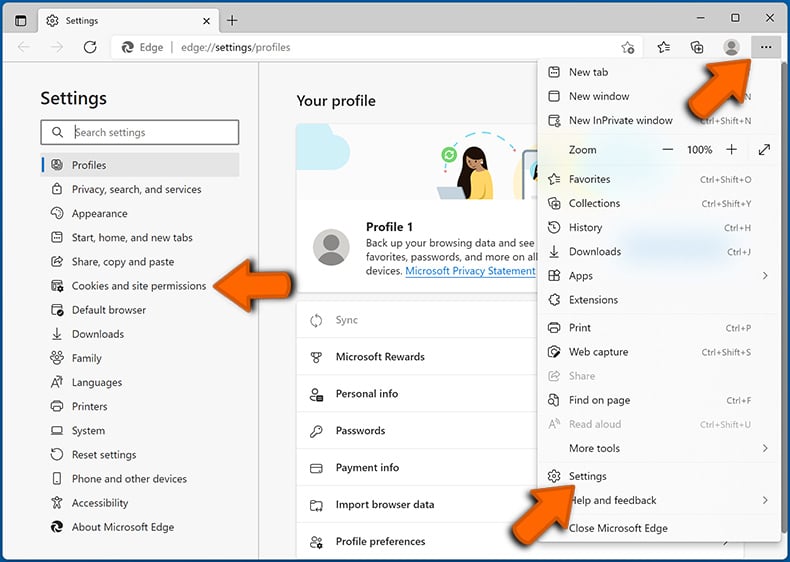
Click three dots on the right hand side of each suspicious URL under "Allow" section and click "Block" or "Remove" (if you click "Remove" and visit the malicious site once more, it will ask to enable notifications again).
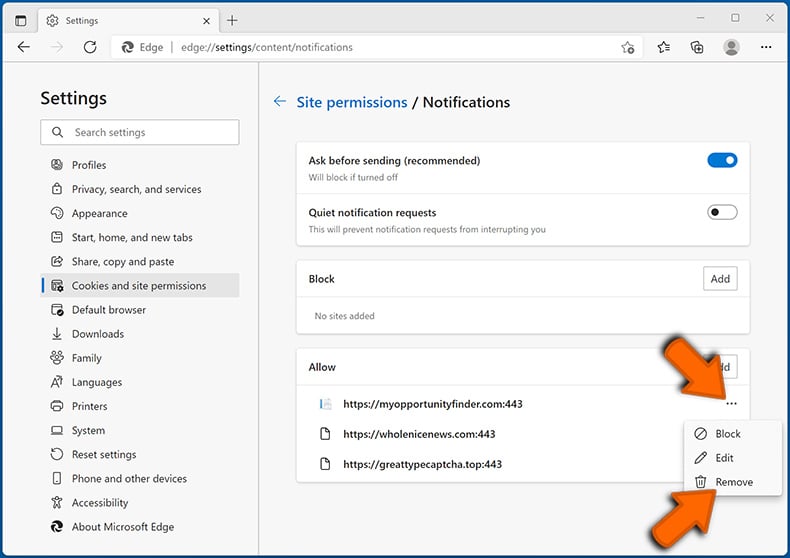
 Remove spam notifications from Safari (macOS):
Remove spam notifications from Safari (macOS):
Click "Safari" button on the left upper corner of the screen and select "Preferences...". Select the "Websites" tab and then select "Notifications" section on the left pane.
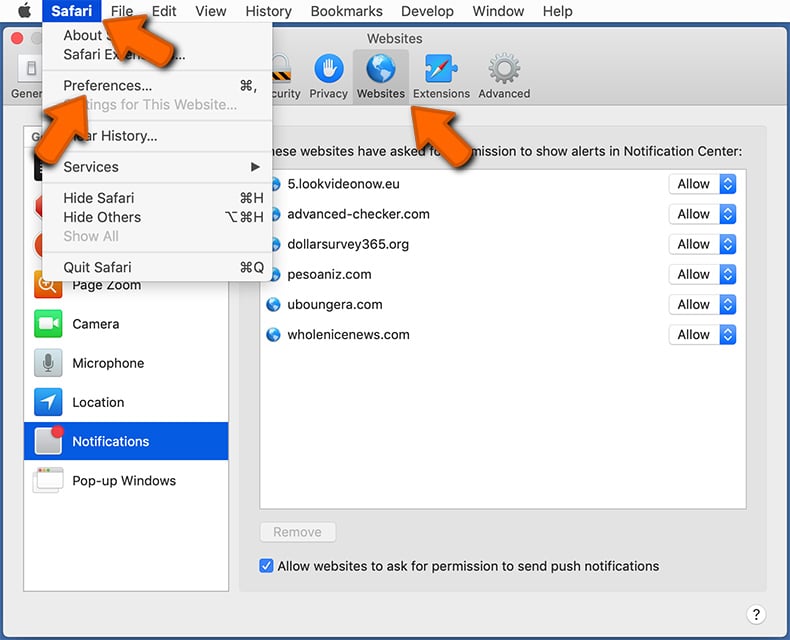
Check for suspicious URLs and apply the "Deny" option using the drop-down menu or either remove them by clicking "Remove" at the bottom of the window (if you click "Remove" and visit the malicious site once more, it will ask to enable notifications again)
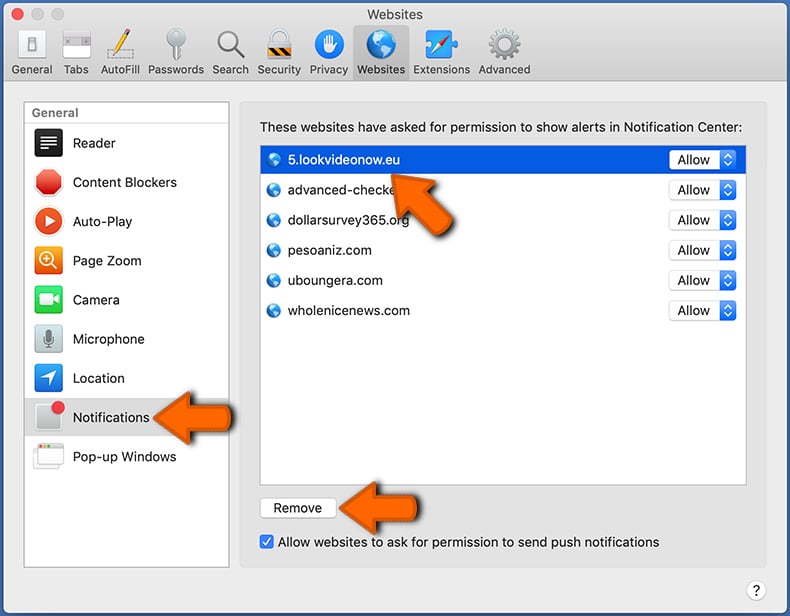
How to avoid browser notification spam?
Internet users should be very skeptical when being asked to allow notifications. While this is a useful feature that allows you to receive timely news from websites you like, deceptive marketers frequently abuse it.
Only allow notifications from websites that you fully trust. For added security - use an anti-malware application with a real-time web browsing monitor to block shady websites that tries to trick you into allowing spam notifications. We recommend using Combo Cleaner Antivirus for Windows.
Frequently Asked Questions (FAQ)
Why am I seeing ads (browser notifications) delivered by coinglide[.]site in the right lower corner of my desktop?
Websites can only send browser notifications if you have given them permission. This suggests that you have likely visited coinglide[.]site before and accidentally granted it permission to send you notifications.
I have clicked on notification ads, is my computer infected?
Clicking a notification itself is not harmful, but clicking notifications from dubious pages can direct users to malicious sites.
Is coinglide[.]site a virus?
Websites like coinglide[.]site are not viruses. They often use the permission to show notifications to deceive users into downloading suspicious apps, paying for fake or unnecessary services, or taking other risky actions.
Will Combo Cleaner remove coinglide[.]site ads automatically or manual steps are still required?
Yes, Combo Cleaner will scan your computer and revoke all permissions granted to coinglide[.]site. It will also block any future access to this site, with no further actions needed on your part.
Share:

Tomas Meskauskas
Expert security researcher, professional malware analyst
I am passionate about computer security and technology. I have an experience of over 10 years working in various companies related to computer technical issue solving and Internet security. I have been working as an author and editor for pcrisk.com since 2010. Follow me on Twitter and LinkedIn to stay informed about the latest online security threats.
PCrisk security portal is brought by a company RCS LT.
Joined forces of security researchers help educate computer users about the latest online security threats. More information about the company RCS LT.
Our malware removal guides are free. However, if you want to support us you can send us a donation.
DonatePCrisk security portal is brought by a company RCS LT.
Joined forces of security researchers help educate computer users about the latest online security threats. More information about the company RCS LT.
Our malware removal guides are free. However, if you want to support us you can send us a donation.
Donate
▼ Show Discussion